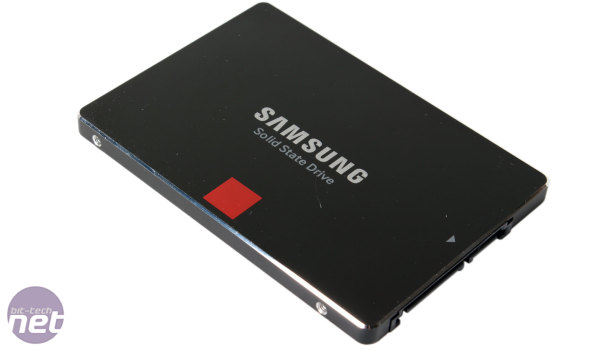
3D V-NAND and Other Improvements
Due to lower program times of 3D V-NAND, performance is up. Sequentially, as with most other modern SSDs, we're still essentially limited by the SATA 6Gbps bus speed, but we see a 10MB/sec read speed increase across and range. However, the best news is that even the 128GB drive is now close to saturating the SATA bus, with an 80MB/sec (20 percent) improvement over the SSD 840 PRO that puts it well ahead of other similar capacity drives. Single queue-depth random read and writes are also up, with writes again benefiting the most, netting a 16 percent increase to 36,000 IOPS.| Samsung SSD 850 PRO | 128GB | 256GB | 512GB | 1TB |
| Max Sequential Read (MB/sec) | 550 | 550 | 550 | 550 |
| Max Sequential Write (MB/sec) | 470 | 520 | 520 | 520 |
| Max 4K Random Read QD1 (IOPS) | 10,000 | 10,000 | 10,000 | 10,000 |
| Max 4K Random Write QD1 (IOPS) | 36,000 | 36,000 | 36,000 | 36,000 |
| Max 4K Random Read QD32 (IOPS) | 100,000 | 100,000 | 100,000 | 100,000 |
| Max 4K Random Write QD32 (IOPS) | 90,000 | 90,000 | 90,000 | 90,000 |
As mentioned, endurance is also up thanks to the 3D V-NAND, which means Samsung has been able to revert back to a larger process node which we believe is in the 40nm class. Samsung claims that endurance has in fact doubled, and it's putting its money where its mouth is by offering a massive ten year warranty compared to five before. This is limited in the same way i.e. no more than 40GB/day of host writes, which if we extend to ten years means the drive is protected by warranty for up to 150TB of total bytes written.
Samsung also tells us that that power consumption of the new NAND is down by about 20 percent, and that the drive has the lowest power consumption of any SSD. While the cache size remains unchanged (i.e. 512MB in the 256GB model we have), it's gone from standard DDR2 to LPDDR2 to further reduce power consumption, and the DEVSLP function is also supported.
The controller, meanwhile, moves from the MDX to the same triple ARM Cortex-R4 core, eight-channel MEX model introduced with the SSD 840 EVO. Clock speeds are the same (400MHz), but the firmware will be very different so as to be able to match and utilise the new NAND effectively. Samsung's vertical integration within the SSD space, whereby it produces and controls all of the main components (NAND, cache, controller and firmware) has always given it a leg up on the competition when it comes to the level of access it has to the hardware.
Data encryption has also been updated from the 840 PRO to bring it in line with the 840 EVO and other competing SSDs. As well as the usual AES 256-bit support, there is compliance with the more advanced hardware level encryption standards TCG Opal 2.0 and IEEE-1667.
Finally, a word on the new Magician software (4.4) which will launch with the drive. We previewed the beta of it, and while the UI remains very much the same – no bad thing, since it's an excellent piece of software as it is. It can be used to guide users through the encryption process, and RAPID Mode has also been updated with new algorithms (no specifics yet) and the ability to utilise up to 25 percent of free system memory, up to a maximum of 4GB in systems with 16GB of RAM or more. The previous limit was 1GB.

MSI MPG Velox 100R Chassis Review
October 14 2021 | 15:04









Want to comment? Please log in.